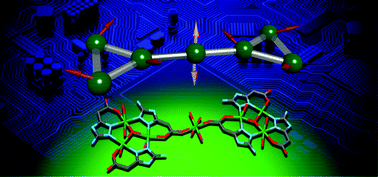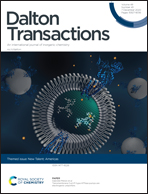Spin-frustration with two quasi-degenerated spin states of a copper(ii) heptanuclear complex obtained from an amino acid ligand†
Abstract
The Cu(II) heptanuclear complex (Cu7atac) was synthesised using the hydrated amino acid ligand 2-(5-amino-1H-1,2,4-triazol-3-yl)acetic acid (Hatac·H2O). Single crystal X-ray diffraction analysis revealed a μ3-hydroxo bridged Cu(II) heptanuclear complex, consisting of two triangular subunits and one Cu(II) ion as a bridge with the formula [Cu7(atac)6(μ3-OH)2(NO3)2(H2O)10](NO3)4. The magnetic behaviour of this discrete 0D complex shows strong antiferromagnetic couplings between Cu(II) mediated by N,N bonding and an anti–anti modes of the carboxylate anion of the ligand atac−. The magnetic data were fitted considering a 3J model. To support the model used to fit the magnetic data of the Cu7atac complex, theoretical calculation methods (complete active space self-consistent field, CASSCF, density functional theory (DFT) using the UKS TPSS/Def2-TZVP//Def2-SVP level and periodic boundary conditions (PBC) using PBE/DZVP-MOLOPT-GTH) were performed to obtain the spin states, spin density map and J couplings. The theoretical results suggest that Cu7atac is a spin-frustrated complex in the ground state, in which the doublet spin state co-exists with the quartet spin state.

- This article is part of the themed collection: New Talent: Americas


 Please wait while we load your content...
Please wait while we load your content...